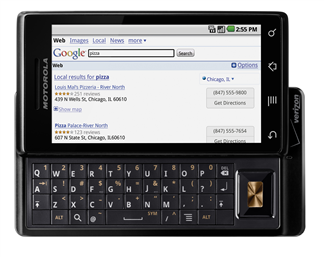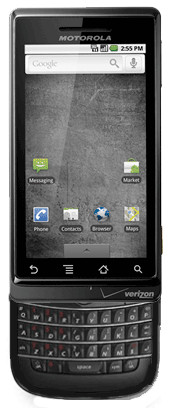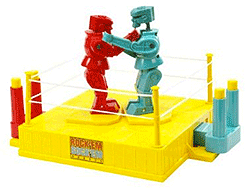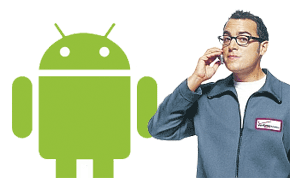
Verizon Wireless’s Droid won’t show up in stores until a week from Friday, but the company has shared loaner devices with technology journalists and bloggers, including me–
PC World has a good roundup of the first reviews. After having spent a bit time with it, I’m not surprised that Verizon is trying to encourage hands-on coverage of the device in the days leading up to its release. A few random thoughts:
Yes, it’s impressive. I keep saying that we’ve been waiting for the first great Android phone, and here it is–Android 2.0 is a much nicer OS than its predecessors, and the Droid shows it off to excellent advantage. No, it’s not an iPhone killer, but I think a meaningful percentage of Verizon loyalists who have been sitting around waiting for a V-iPhone will get this instead, and be pleased. And there are certain things about the Droid–the screen, the openness, Google Maps with navigation for free–that’ll provoke a feeling iPhone users aren’t used to: envy.
High-resolution screens are going to change smartphones. The Droid’s 854-by-480 screen is a delight–it allows for a dozen thumbnail previews of Web pages that are crisp enough to be recognizable, and Google Maps satellite imagery dazzles. If I were the maker of any other touchscreen smartphone, I’d be scrambling to match it right now.
The Droid flies, mostly. The phone’s relatively robust tech specs compared to previous Android phones pay off: The interface generally matches the fluidity of the iPhone (with a few exceptions–when you pull down the list of status updates, it’s herky-jerky) and the browser, like that of the iPhone 3GS, is a joy to use. I need to use the phone in more places before I form conclusions about data speed, but I have noticed that sites designed for use on mobile devices seem to pop into place–no waiting required.
The keyboard is a plus, but not for the reason you might think. I’ve come to the conclusion that vertically-oriented phone keyboards like the ones on BlackBerries and the
Palm Pre are more usable than horizontal ones like the Droid’s, because they let you thumb-type without having to stretch your hands too much. And while the Droid keyboard is decent, the phone’s thin case doesn’t leave much room for travel. But here’s why I’m glad the Droid has a keyboard: It leaves all of the phone’s pixels available for stuff that would otherwise be eaten up by the on-screen keyboard. That’s a boon for apps which require a keyboard all or most of the time, such as instant messengers and word processors.
The iPhone still rules for entertainment. This is an area where Android 2.0 doesn’t seem to have changed much–it’s still got a music player and a video player and an integrated version of Amazon’s MP3 store, but the apps are pretty basic and there’s no way to buy or rent movies or TV shows. Eventually, Android’s openness could make it a more appealing media platform than the iPhone, since purveyors of content will be able to develop cool apps without worrying about whether Apple will approve them, and audio-related ones can run in the background. But for the moment, Android 2.0 feels like Google has ceded the media race to Apple. And Verizon and Motorola didn’t do anything to compensate.
The iPhone OS is still more elegant and intuitive. You can pick up an iPhone and figure out nearly every feature (keyboard excepted) with virtually no learning curve, and once you know what to do, you can do it with remarkable swiftness. Android, on the other hand, is solid overall, but it feels a little more like a desktop OS that’s been shrunken to phone size. There are things that are hard to remember–every time I pick up an Android phone, I need to retrain myself on some tasks, such as how to install widgets. on the desktop
The Droid isn’t Verizonized. When word began to leak out about the Droid, lots of skeptics said that Verizon Wireless would hobble Android. On the review unit loaned to me by the company, however, there’s little evidence of Verizon’s involvement except for its logo on the case. It feels like an Android phone, not a Verizon one, and seems as open as any other Android device.
Google Maps with Navigation rocks. I said that iPhone owners might be envious of certain Droid features, and this would be one of them. So is Google Voice (which isn’t preinstalled on the phone, but is available on the Android Market rather than being stuck in
App Store approval limbo).
More thoughts to come–anything in particular you’d like to know about the phone?
 Verizon Wireless starts selling its first Android phone, the Droid (“by Motorola”) today. I’ve been using a unit loaned to me by Verizon for a week, and remain mostly impressed: The Droid couples impressive hardware with the much-improved Android 2.0 OS, and the result is the first Android phone that’s fully worthy of being compared to the iPhone 3GS and Palm’s Pre. (It’s most definitely an example of the class of device that Walt Mossberg calls “super-smart phones.”)
Verizon Wireless starts selling its first Android phone, the Droid (“by Motorola”) today. I’ve been using a unit loaned to me by Verizon for a week, and remain mostly impressed: The Droid couples impressive hardware with the much-improved Android 2.0 OS, and the result is the first Android phone that’s fully worthy of being compared to the iPhone 3GS and Palm’s Pre. (It’s most definitely an example of the class of device that Walt Mossberg calls “super-smart phones.”)
 Verizon Wireless has been bashing AT&T and its products lately, in both its
Verizon Wireless has been bashing AT&T and its products lately, in both its  Verizon Wireless’s Droid won’t show up in stores until a week from Friday, but the company has shared loaner devices with technology journalists and bloggers, including me–
Verizon Wireless’s Droid won’t show up in stores until a week from Friday, but the company has shared loaner devices with technology journalists and bloggers, including me– So
So  Google’s Android phone OS may have gotten off to a slower start than I’d have expected, but it’s quickly making up for lost time. Today’s news:
Google’s Android phone OS may have gotten off to a slower start than I’d have expected, but it’s quickly making up for lost time. Today’s news:  Responding to pressure on government regulators, Verizon Wireless has announced it would limit the length of its exclusivity agreements with wireless manufacturers to six months. However, for carriers to pick up a Verizon-exclusive phone after that period, it would need to have less than 500,000 customers.
Responding to pressure on government regulators, Verizon Wireless has announced it would limit the length of its exclusivity agreements with wireless manufacturers to six months. However, for carriers to pick up a Verizon-exclusive phone after that period, it would need to have less than 500,000 customers.